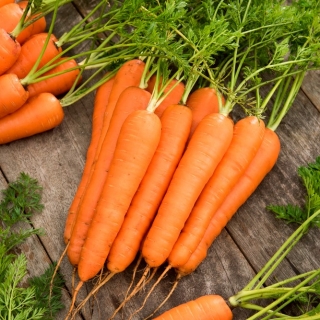The 'Knota F1' carrot is a hybrid cultivar that produces large roots. It belongs to medium large varieties and its vegetation period lasts 95 to 100 days. It is perfectly suited for forced cultivation under covers, the early harvest in bundles and all year cultivation on the field. Its cylindrical roots that grow 18 to 20 centimetres long are resistant to breaking, do not discolour and their tops do not green. Their flesh is uniformly orange. The fact that they can be harvested mechanically belongs to advantages of this variety that is also resistant to black leaf spot that can cause huge losses in carrot cultures.
Carrot roots constitute a rich source of various compounds, from carbohydrates, through proteins and pectin, to carotenes. Orange flesh of the carrots contains vitamins B, C, E, H, K and PP. There are trace elements in carrots too. The consumption of this vegetable supplies you with calcium, magnesium, natrium and potassium. This low-calorie and digestive vegetable is recommended to those who suffer from the digestive tract diseases. It strengthens the body, prevents from arteriosclerosis and improves the sight in the darkness.
Carrot is a popular and commonly grown crop. It can be found in the majority of home gardens, because it is rather unproblematic. Everyone who gives the plants just a little bit of attention can grow large delicious roots. Carrot grows well in sandy-loam soils and likes lighter, sandy soils too. It cannot stand heavy and water-logging soil. Choose sunny and sheltered sites for carrot cultures. Sow carrot seeds in early spring every 5 to 6 centimetres in rows circa 40 centimetres apart. The roots are harvested gradually as they mature. The varieties intended for winter storage have to be harvested before the first frost in autumn.
Calibrated seeds (divided into groups according to their size) ensure better germination and higher vigour. You will be able to notice the higher quality of the emergence already during growing seedlings. This feature directly translates into the improved crop quality and volume. The carefully selected seeds of similar size allow for more precise sowing that can be up to 20% more effective than when using traditional seeds. Various scientific research programmes prove that calibrated seeds display they highest vigour and germination rates. They ensure evenly sized, great looking crops.
Each package contains 25000 professional calibrated seeds sized 1.8 to 2.0. The growing instructions and the sow-by date can be found in the packaging information.
- Harvest time: 95 to 100 days after the start of cultivation
- Site: sunny; sandy-loam, lighter soil
- Quantity (if applicable): 25000
GardenSeedsMarket - has been in business for more than a decade and from the very beginning we have made the quality of our products the top priority. Throughout the years we have delivered the best quality goods to tens of thousands of customers from all over the world. Their satisfaction proves that we had chosen the right way.
All seeds we sell are subject to a multi-level quality control checks and only then are carefully packed and dispatched. Our products have been awarded numerous certificates and comply with the highest standards of the European Union. Our employees are experienced gardeners who are more than happy to answer your every question.
Where do our seeds come from?
All of the seeds sold in our shop come from the best producers from across the European Union. Thanks to a long-standing cooperation with them we were able to develop the most adequate storing and dispatch conditions, guaranteeing that you always receive fresh and carefully tested batches of seeds. Exclusion of the middlemen from the whole process not only makes it possible for us to avoid sending out-of-date seeds that might have been lying too long on a warehouse shelf, but also ensures the most attractive price for top quality products.
The quality control process
All our seeds must pass a four-stage quality control process.
Stage one begins with a careful selection of the suppliers. Than we proceed with controlling their crops, foreign producers are not excluded from the quality control process. Plants are checked at every stage of their development: when they start to grow, during blooming and when they start bearing fruit (seeds). At this stage the most important thing is to ensure proper spacing of the plants. Thanks to that obtaining the desired morphological characteristics of each particular species or variety, such as colour, height and shape, can be ensured.
Stage two consists of a detailed verification tests in laboratory conditions. With the use of the highest quality equipment by the highly qualified staff, our suppliers perform more than 30 000 quality checks annually. The seeds that do not meet our requirements are subject to technological refining processes, including drying, cleaning, upgrading and testing again.
Stage three starts with sowing seeds in selected control plots. That way we obtain valuable, exact information concerning their germination that must be maintained at an appropriate level. Simultaneously, the varietal identity of each species is checked at this stage.
Stage four takes place in our warehouses and consists of eliminating seeds that have been stored for too long on our shelves and replacing them with new batches. Each package is stamped with a unique batch number and also with the sow-by-date.
All four stages combined allow us to state with confidence that the seeds we deliver comply with the highest standards and have completed all required control stages with flying colours.
Prizes and awards
The seeds we sell are widely recognized for their quality and have won many awards. Our seeds won numerous gold medals and distinctions for their high quality. The World of Flowers was also honoured for its innovative approach.
Among those awards there were: TOP INNOVATION (June 2015), GOLD MEDAL AT THE POZNAN INTERNATIONAL FAIR (2015), CONSUMER QUALITY LEADER (2014), FARMER OF THE YEAR (2014).
In addition, we have also been awarded the “IDEAL BUSINESS” certificate for two years in a row.
Germination
We are committed to selling only the highest quality seeds. Taking into consideration the efforts we make daily, please also note that plants are living organisms and their germination and growth depends on many factors, such as temperature, soil type, humidity and the frequency with that they are watered, sowing time and conditions, use of fertilizers and plant protection agents (pesticides), as well as weather and climate conditions. We provide help by sharing the accurate and up-to-date sowing and growing information, however, we cannot bear any responsibility for the plants that were not cultivated in conditions appropriate for given species.







